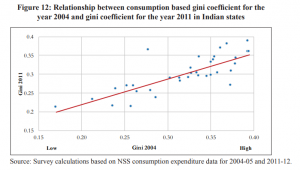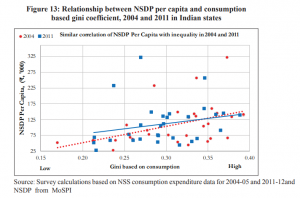
A persistent decline in labour share has been visible in many developed and developing economies since the 1980s. Declining labour share leads to widening income inequality, demand constriction and slowdown of economic growth. National income is the sum of all income generated in a country in a year. The division of national income between labour and capital is called the functional distribution of income. The labour income share is the part of national income allocated to labour compensation, while the capital share is the part of national income going to capital.
A falling labour share often reflects the more rapid growth in labour productivity and an increase in returns to capital relative to labour. There are serious negative consequences of declining labour share. The most important repercussion is an increase in income inequality in a context where GDP growth will not ensure better equitable distribution of wealth. Data shows that over time and across many countries, a higher capital share is associated with higher inequality in the personal distribution of income (Piketty 2013).
A large majority of the population suffers from low income, aggregate demand remains depressed, leading to a glut or over-production leading to a decline in investment. Subsequently exports and consumption both tend to fall.
READ I The nations within: Inequality poses a big challenge for India
Labour share falling globally
In recent years, a growing body of evidence suggests that labour shares have experienced a secular downward trend. The labour share of income – the share of national income paid in wages, including benefits, to workers – has declined globally since the early 1990s. Data aggregated by various institutions like Organisation for Economic Cooperation and Development, the International Monetary Fund, the International Labour Organisation and the European Commission suggest that the share of labour compensation in national income in 25 most advanced economies fell from 66% in the early 1990s to roughly 62% to the present day.
It is observed in the OECD countries that over the period from 1990 to 2009 the share of labour share in national income declined in 26 out of 30 countries. The median (adjusted) labour share of national income across these countries fell from 66.1% to 61.7%. A more recent OECD calculation finds that the average adjusted labour share in G20 countries went down by about 0.3 percentage points per year between 1980 and the late 2000s.
In the case of emerging and developing economies, the evidence appears to be more mixed and somewhat ambiguous. Nonetheless, the ILO finds that in many emerging and developing countries the decline in the labour income share is even more pronounced than in advanced economies, with considerable declines in Asia and North Africa and more stable but still declining wage shares in Latin America (ILO-IILS, 2011).
The downward trend since the 1990s is also observed by ILO, whose estimates of the adjusted and unadjusted labour shares are based on main national accounts from UN Data. The adjusted labour shares decline from an average of about 58% to about 55%, and the unadjusted labour share falls from 51% to 49%.
READ I Widening inequality: Societies need to address economic, ethical dimensions
Income inequality in India
In India, too, a declining wage share has been witnessed since the 1980s. The proportion of labour share in national income in India has declined from 38.5% in 1981 to 35.4 % in 2013, according to the Wage Report by the International Labour Organisation in 2018.
As a result, India has seen a high concentration of income and wealth (profits, rent and other income from capital) at the top decile and centile (the top 10% and 1% of the population). In the 1980-2015 period, the top 0.1% of earners captured a 12% share of total growth while the bottom 50% got 11%. In the same period, the top 1% received 29% total growth while the middle 40% received 23% of the national income, wrote Lucas Chancel and Thomas Piketty.


Between 1993 and 2012, Indian GDP grew at an annual average rate of 7%, which has no doubt reduced poverty to some extent. But what is often overlooked is the fact that since the reforms began, the top 1% have walked away with about 30% of national income, leading to higher income inequality.
As the statistics above show, the creation of wealth in India has not been distributed equally at all. Between 1947 and 1985 (when the Indian economy was centralised and highly regulated), the wealth of the bottom 50% of the population grew at a faster rate than the national average. On the other hand, since 1985, the top 0.1% of Indians have captured more wealth than all of the bottom 50%. The middle 40% has also seen very little growth in this period. Since 2014, there has been a significant reduction in average per capita expenditure and a sharp rise in unemployment (it was 7.8% before Covid-19) and deceleration in wage rate growth.
India vis-a-vis other countries
India recorded an average real wage growth (nominal wages discounted by inflation) of 5.5% in the period 2008-2017 (which is often picked up by the government and the mainstream Indian media as a major government achievement). But what is not highlighted is that in the same period Germany has seen an 11% increase, South Korea a 15% increase and China almost 100% increase in the average real wages.
Australia, the United States, France and Canada are the other advanced G20 countries have experienced positive wage growth in the range of 5% to 7%. But as the base wages in advanced G20 countries were several times greater than that in India, the 5% to 7% increase in their wages means their workers earn substantially earn more and also have greater purchasing power than Indian workers.
In China, France, Germany, UK and US, there has been a raging debate on income inequality and the need for making income distribution fairer and more equitable, expanding the size of the middle-income group, increasing income for people at the bottom 50% and adjusting national income redistribution.
India’s income profile is outlined by a growing disparity between those who lie on the top end of the earning pyramid and those on the bottom, as revealed in a report by the government titled ‘The State of Inequality in India’. It was commissioned by the Economic Advisory Council of the Prime Minister (EAC-PM) and was prepared by the Institute for Competitiveness. It tried to give a comprehensive overview of the state of inequality in the country by looking at various indicators like income profile, labour market dynamics, health, education and household amenities.
The report moves beyond the wealth estimates that depict only a partial picture to highlight estimates of income inequality during the periods of 2017-18, 2018-19 and 2019-20. With a first-time focus on income distribution to understand the capital flow, the report emphasises that wealth concentration as a measure of inequality does not reveal the changes in the purchasing capacity of households.
Extrapolation of the income data from PLFS 2019-20 has shown that a monthly salary of Rs 25,000 is already amongst the top 10% of total incomes earned, pointing towards acute income disparity. The share of the top 1% accounts for 6-7% of the total incomes earned, while the top 10% accounts for one-third of all incomes earned.
In 2019-20, among different employment categories, the highest percentage was of self-employed workers (45.78%), followed by regular salaried workers (33.5%) and casual workers (20.71%). The share of self-employed workers also happens to be the highest in the lowest income categories. The country’s unemployment rate is 4.8% (2019-20), and the worker population ratio is 46.8%.
The Economic Advisory Council to the Prime Minister (EAC-PM) suggested that the government should come out with a guaranteed employment scheme for the urban unemployed as well as introduce a universal basic income and allocate higher funds towards the social sector to reduce inequality in India. Without a somewhat equitable distribution of income, it is not possible to improve aggregate demand and subsequently investment and growth.
A decent GDP growth path over a sustained period is not possible without income being fairly equitably distributed among the population. A very skewed distribution, where the top 1 percent or 10 percent corner a significant part of the national income, will lead to a situation where growth remains confined in a very narrow realm of things and the majority of the population remains impoverished.
Dr Kingshuk Sarkar is an associate professor at the Goa Institute of Management. He has worked as a labour administrator with the government of West Bengal. He earlier served as a faculty member at VV Giri National Labour Institute, Noida and NIRD, Hyderabad. Views expressed are personal.


